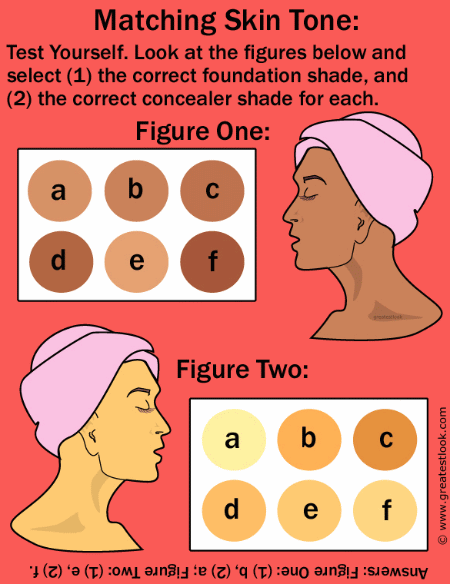Make-Up Techniques (3)
Previous Page
A concealer should be one shade lighter than the skin's actual tone. This means that it will be visible when initially applied, but will blend quickly to be invisible when blotted and covered by the foundation (or tinted moisturizer).
Remember only to lightly dab concealer onto the area you want to cover-up. Using too much concealer (especially around the eyes) can result in a raccoon-type effect, or the eyes looking puffy. Concealer should be replaced at least every six months.
Foundation is typically a translucent liquid or moist powder make-up that is designed to even out skin tone and create the appearance of smooth clear skin. Foundation is usually applied with a cosmetic sponge and should be applied using a gentle, dabbing motion for a matte finish. The reason for using the dabbing motion is two-fold. One, by dabbing the foundation onto the skin, you minimize the risk of rubbing off any concealer and negating its effects.
Two, dabbing the foundation allows you more control over the amount of make-up you apply. Some women have a tendency to place dollops of foundation on different areas of the face and spread it around using their fingertips. This can lead to uneven application and a line of demarcation or "swirl patterns" on the face, which as the foundation begins to set can only be covered by applying more make-up.
Your foundation should match your skin tone as closely as possible. When your foundation is applied, it should vanish immediately. If you can see where the foundation has been applied then the foundation is either too light or too dark for your skin tone. After you've applied your foundation, let it sit for a few moments to set.
Foundation should be replaced at least every six months.
(Trivia Fact: Long before the creation of foundation make-up, women used powder to soften the skin tone and give the illusion of even skin. This was most prevalent in eras when pale complexions were the most desired.)
Finishing Powder:
Finishing powder is a translucent powder make-up that is designed to set the foundation make-up and prevent shine, ensuring a natural-looking, matte finish. Once you've applied your moisturizer, concealer, and foundation, lightly dust the face with finishing powder using a large applicator brush. The finishing powder should be as close to the same shade as your foundation make-up as is possible.
Once you've applied your finishing powder, your face should look as though it is freshly washed, but not as though you are obviously wearing make-up. Finishing powder should be replaced at least every six months.
Eyebrow Pencil:
The eyebrow pencil is a crayon-like stick make-up that is used to fill-in sparse or overly-light eyebrows. Most eyebrow pencils come with a blending tool on one end in order to soften the effect. You should choose a shade of pencil that matches your hair color or is slightly lighter.
Avoid over-drawing the eyebrows, as the result is an artificial look. Use light, short strokes to add color and fill in any gaps or sparse areas of the brow. Eyebrow pencils should be replaced at least every six months.
The Difference between Day and Night Make-ups:
At this point, the make-up techniques and colors used to apply the make-up diverge depending on whether you are applying the make-up for daytime or nighttime wear.
Next Page Page 1 Page 5 Page 6